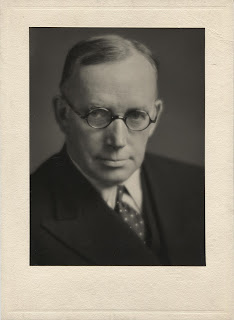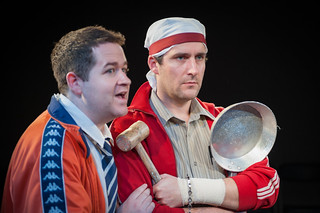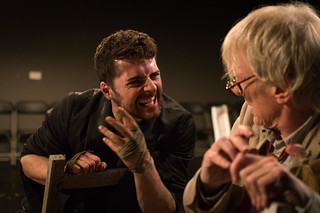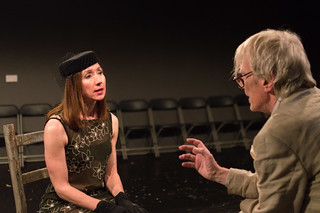A Short History of the Close Theatre Club
We're at the heart of our Up Close season celebrating the 50th anniversary of the establishment of the notorious but short-lived Close Theatre. We asked Jenny Knotts to share some of her research on The Close Theatre.
On the
evening of Tuesday 29th September 1964 throngs of cars carrying
guests and supporters of the Glasgow Citizens Theatre drew up along Gorbals
street. The occasion was a Gala evening to celebrate the 21st
anniversary of the company. Adorned in evening wear, a stipulation usually
reserved for opening nights, audience members poured into the majestic foyer
ahead of the main event- a revival of James Bridie’s ‘A Sleeping Clergyman’,
 |
| Citizens Theatre founder James Bridie |
As the
curtain fell, the Chairman of the Board of Directors, Michael Goldberg, took to
the stage to herald the imminent opening of a new, workshop theatre, adjunct to
the Citizens, that would devote itself to theatrical experimentation. This
intimate theatre would provide artists with a space to explore new texts and
techniques free from the constraints and pressures of the proscenium arch. The
announcement was met with rapturous applause and extensive media coverage as
plans for the latest venture of the Citizens Theatre Company, and certainly its
greatest since its move to Gorbals Street from the Athenaeum in 1945, got
underway.
Nearly a
decade later, in May 1973, staff and helpers scrambled among the ashes of the
destroyed Close Theatre Club in a bid to
salvage some evidence of the near 200 productions that had taken place ‘up the
close’ at 127 Gorbals Street. Nowadays there is no physical remembrance of the
Close, however its legacy can be found not only in the Tron Theatre, which was
eventually formed to help fill the void created by the 1973 fire, but also in
the very nature of modern theatre in Scotland. Despite its untimely demise, the
Close Theatre Club altered the landscape of Scottish theatre forever.
 |
| The Close Theatre was destroyed by fire in 1973. |
The Close
Theatre club was born from an ongoing rumbling of unrest, both within its
parent theatre, the Citizens, and in the wider Scottish theatre community. The
Citizens came under a great deal of pressure from patrons and the press to
produce more new work. Aware of these demands and the building’s own growing pains,
Goldberg, kept a watchful eye on a former dance hall, now notorious pitch and
toss club which lay directly adjacent to the Citizens. In a fittingly dramatic
twist of fate, a violent murder led to the immediate closure of the club.
Goldberg seized the opportunity and stepped in.
The idea of a
small experimental theatre was not merely enthusiastically welcomed but seemed
impertinent to the company’s development. As Director of Productions, Ian
Cuthbertson attested: “Every industry has its research department: the theatre
is in no way different, only well behind.” This view was shared by those
involved in the project and minutes from the inaugural meeting note:
It was agreed
that this would be an exciting venture giving the opportunity for trying out new
actors, new plays and new playwrights and also the opportunity to give full
time work to more actors.
From the outset it was decided that the Citizens and Close theatres would complement each other wherever possible, sharing both facilities such as scenic workshops, and staff including actors and technicians. One actor, Dermot Tuohy, managed to perfectly embody this mutual benefaction in the early days of the Close by playing a small role in first act of the main stage production, then dashing offstage and upstairs to play a prominent role in the second piece in that night’s Close double bill.
 |
| Ross Allan and Robert Jack in Out At Sea as part of the Up Close Season |
From the outset it was decided that the Citizens and Close theatres would complement each other wherever possible, sharing both facilities such as scenic workshops, and staff including actors and technicians. One actor, Dermot Tuohy, managed to perfectly embody this mutual benefaction in the early days of the Close by playing a small role in first act of the main stage production, then dashing offstage and upstairs to play a prominent role in the second piece in that night’s Close double bill.
The Close
quickly carved a niche for itself in staging lesser seen works by well-known
writers as well as brand new pieces. Olwen Wymark’s first play Lunchtime Concert was a notable success
in the early years of the venture and was later revived in a triple bill of the
playwright’s work-testament to the theatre’s dedication to developing emerging
artists. One act plays were preferred, with audiences usually being treated to
a double bill – on occasion returning after the interval to discover the layout
of the theatre had changed entirely during the interval from apron to in-the-round
– such was the diversity of the space. Later script readings, film nights,
opera and even ballet would grace its versatile stage.
 |
| Director Charles Marowitz''s Doctor Faustus in The Close Theatre caused controversy |
An infamous
episode in 1965 involving Charles Marowitz and an interesting interpretation of Doctor Faustus and a mask of the queen’s face, resulted in the abandonment of the
opening night performance in favour of an impromptu debate between audience and
management about whether or not the show should go ahead. The incident afforded
the club its first front page controversy, and sparked interest far and wide in
the new little theatre. With membership soaring to over 2,000 the Close firmly
cemented its position as the most theatrically exciting venue on the west
coast.
With the
arrival of Giles Havergal, Philip Prowse, and later Robert David MacDonald, the Close theatre continued
to be a hive of theatrical experimentation and boundary shattering productions.
So too, however, was the main stage. While the Close undoubtedly offered
theatre goers a unique experience in the intimate nature of the auditorium and
the buzzing social hub of the bar, it was no longer the only place on Gorbals
street one could find theatrically outlandish and exciting work. Of course
there were certain productions that would never have been possible, or as
effective, on the Citizens main stage such as Artaud’s The Cenci which hit
headlines with its naked photo call and introduce Scottish theatregoers to
concept of the Theatre of Cruelty. In the latter days, just as popular as the
productions themselves were the nightclub and restaurant (doubling as staff
canteen) which made the Close both the place to be and to be seen.
Yet its
original purpose was no longer quite as urgent as it had been in the early
years of its life. In the years following the fire Giles told Michael Coveney
“In the old days the Close was a leech, using a lot of manpower and resources, and it drove us mad. But once we were up and running we felt differently about its loss – to the extent that, today we feel we could once again do with another space.”
Of course the Citizens would later acquire not one, but two
studio spaces each of which hosted some of the company’s most exciting work.
 |
| Daniel Cahill and Cliff Burnett in Lot and His God as part of the Up Close Season |
until 24 October
By Sławomir Mrożek
Directed by Matthew Lenton
Presented in association with Vanishing Point
31 Oct - 7 Nov
By Sam Holcroft
By Sam Holcroft
Directed by Gareth Nicholls, Citizens Theatre Main Stage Director in Residence
References:
Scottish
Theatre Archives, University of Glasgow Library
Magic in the Gorbals, Cordelia Oliver
The Citz, Michael Coveney
‘Up the Close: The Close Theatre at the Citizens’, Glasgow’ J Riddel


Comments